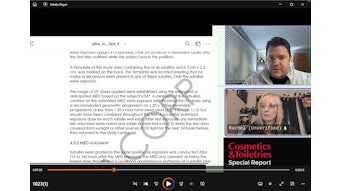
Read the full article in the June 2021 digital edition. . .
While the UK is now a third country to the European Union (EU), having left the European Common Market and Customs Union on December 31, 2020, the UK cosmetics industry and businesses in other international areas who wish to market cosmetic products in the EU are still affected by changes to the EU Cosmetic Products Regulation (CPR) and REACH (the Registration, Evaluation, Authorization of CHemicals) regulation. Several key ingredients or groups of chemicals are under review by the European Chemicals Agency (ECHA) via REACH; in particular, D4/D5/D6 and microplastics.
Cyclic Siloxanes
Cyclic siloxanes are important ingredients in many cosmetic products including hair care, skin care, deodorants and makeup. For many applications, no suitable alternatives exist.
Under REACH in the EU, cyclotetrasiloxane (D4), cyclopentasiloxane (D5) and cyclohexasiloxane (D6) have been assessed for their potential environmental impact. The UK was designated the responsible authority for conducting this assessment.
In June 2014, the UK authorities notified their intention to submit a restriction dossier under REACH, limiting the use of D4 and D5 in wash-off cosmetic products to less than 0.1%. In December 2016, the European Commission asked ECHA to prepare a dossier to also propose a restriction on the use of D4 and D5 in leave-on cosmetics. D6 was also added to the proposed restriction. However, by this time, D4 was being banned in cosmetics on different grounds, so it was no longer of interest. The deadline for placing wash-off cosmetic products containing D5 at a concentration greater than 0.1% on the EU and UK market under the REACH Restriction was January 31, 2020.
Although data from environmental monitoring studies demonstrated that the existing restriction on wash-off products has significantly reduced the level of cyclic siloxanes in the aquatic environment, and is the most appropriate risk management measure, a REACH restriction on D5 and D6 in leave-on cosmetic products and D6 in wash-off products is being progressed.
Annex XV REACH Dossier, investigating usage restrictions of D4, D5 and D6 in leave-on consumer or professional cosmetic products at a maximum concentration of 0.1%, was published in January 2019. This restriction proposal also includes the use of D6 in wash-off products, in line with the restriction that has already been published for D4 and D5.
The two main committees of ECHA that review restriction proposals are the Committee for Risk Assessment (RAC) and the Committee for Socio-economic Assessment (SEAC). Both have supported the proposed actions.
Publication of the restriction is expected in 2021. Once published, the transition periods for the EU will begin: 5 years for D5/D6 in leave-on formulations; and 2 years for D6 in wash-off formulations.
For Great Britain (England, Scotland and Wales), because the restriction will be published in the EU after the UK has completely left, this restriction will not automatically be included in the UK REACH. Great Britain must develop a separate proposal if it considers this appropriate. However, cosmetic products destined for the Northern Ireland market will need to comply with the EU REACH Restrictions.
These actions are restrictions under REACH. However, in March 2020, ECHA launched a public consultation on its proposal to include seven substances identified as Substances of Very High Concern (SVHC) to Annex XIV (the authorization list) of the EU REACH Regulation. These substances include D4, D5 and D6.
Currently, no substances authorized under REACH are used in cosmetic products. The EU and UK cosmetic regulations ensure that only safe cosmetic products may be placed on the market. The strict processes in place under these regulations ensure safety for consumers and professional users are well-recognized because Article 56.5(a) of the EU and UK REACH regulations state that authorization requirements based on human health concerns do not apply when the substance is used in cosmetic products since its use is already regulated by the EU and UK cosmetic regulations.
Any authorization requirements for D5 and D6 will likely further restrict the use of these vital ingredients.
. . .Read more in the June 2021 digital edition. . .
References
- European Chemicals Agency (ECHA). (2020, Dec 10). Committee for risk assessment (RAC) and committee for socio-economic analysis (SEAC): Opinion on an annex XV dossier proposing restrictions on intentionally-added microplastics. Available at: https://echa.europa.eu/documents/10162/a513b793-dd84-d83a-9c06-e7a11580f366











